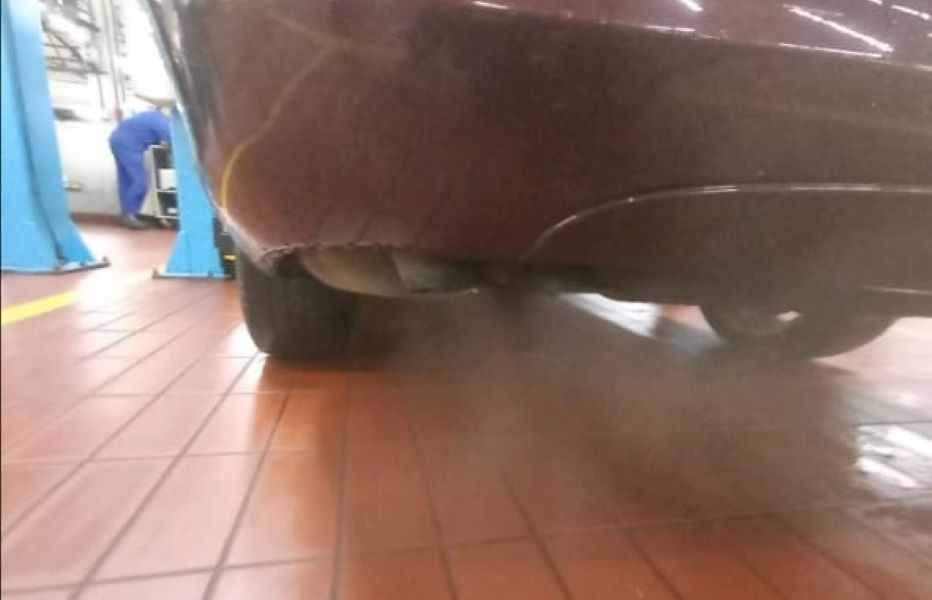Table of Contents
White Smoke From Exhaust: A Case Study on Mercedes-Benz E Class W211 with OM646 Engine
Experiencing white smoke from exhaust can be alarming for any vehicle owner. This issue often indicates a serious underlying problem that requires immediate attention. In this article, we will address a real-world case involving a Mercedes-Benz E Class W211 equipped with the OM646 engine.
The vehicle exhibited excessive white smoke from exhaust, traced back to engine oil leaking into the turbocharger. By following this step-by-step guide, readers will understand how to diagnose and fix similar issues effectively.

Customer Complaint: white smoke from exhaust pipe
The vehicle owner brought their Mercedes-Benz E Class W211 to the workshop, reporting persistent white smoke from exhaust under both idle and acceleration conditions. This excessive smoke not only reduced driving comfort but also posed a potential risk of further engine damage if left untreated.
Initial Symptoms Observed:
- Continuous white smoke from exhaust, particularly at start-up and under load.
- Noticeable oil consumption.
- Reduced engine performance and occasional hesitation.

Diagnosis and Visual Inspection
To pinpoint the cause of the white smoke from exhaust, a thorough inspection of the engine and exhaust system was carried out. Here’s the step-by-step diagnostic process:
1. Checking for Coolant or Oil Contamination:
- Coolant leaks and oil infiltration are common culprits behind white smoke from exhaust. In this case, coolant levels were stable, eliminating a head gasket issue as the cause.
2. Inspecting the Turbocharger System:
- Upon removing the intake piping and visually inspecting the turbocharger, significant oil contamination was observed. Engine oil had infiltrated the turbocharger, seeping into the exhaust side. This oil leakage was confirmed as the source of the excessive white smoke from exhaust.
3. Testing the Turbocharger Shaft Play:
- The turbocharger shaft was tested for axial and radial play. Excessive shaft play indicated wear on the internal seals and bearings, which allowed engine oil to leak into the turbocharger housing.
4. Confirming the Root Cause:
- The faulty turbocharger seals failed to prevent oil from entering the exhaust stream, resulting in the visible white smoke from exhaust. The turbocharger unit required replacement to resolve the issue.

Solution: Turbocharger Replacement
Once the diagnosis confirmed that a faulty turbocharger caused the white smoke from exhaust, the following steps were taken to resolve the issue:
1. Removing the Faulty Turbocharger:
- The intake pipes, exhaust manifold, and related connections were carefully removed. Special care was taken to avoid contaminating surrounding components with leaked oil.

2. Cleaning the System:
- All intake and exhaust piping were cleaned thoroughly to remove any residual oil. Contaminated pipes or intercooler sections were inspected for damage and replaced if necessary.
3. Installing the New Turbocharger Unit:
- A brand-new turbocharger was installed to replace the faulty unit. The turbocharger was pre-lubricated to prevent dry start-up damage.


4. System Reassembly and Inspection:
- The turbocharger, intake, and exhaust components were reassembled, ensuring all connections were tight and free from leaks.
5. Oil and Filter Replacement:
- Engine oil and filters were replaced to eliminate any contamination caused by the failed turbocharger.
6. Final System Check:
- The engine was started, and a complete system check was performed. This included:
- Monitoring for residual white smoke from exhaust.
- Checking turbocharger boost pressure and performance.
- Ensuring there were no oil or exhaust leaks.
Results: Problem Solved
The replacement of the faulty turbocharger successfully resolved the issue. The engine performed optimally with no further signs of white smoke from exhaust pipe. Key results include:
- White smoke from exhaust eliminated.
- Improved engine performance and responsiveness.
- Stabilized oil consumption.
The customer was satisfied with the repairs and regained confidence in their Mercedes-Benz E Class.
Is White Smoke From Exhaust Bad?
Yes, white smoke from exhaust can indicate serious engine problems that should not be ignored. Here are key reasons why it is bad and what it signifies:
1. Oil or Coolant Contamination:
- White smoke often results from engine oil or coolant entering the combustion chamber or exhaust system. This contamination can cause damage to engine components over time if not addressed.
2. Engine Performance Issues:
- Persistent white smoke from exhaust pipe usually accompanies performance problems, including rough idling, hesitation, or power loss.
3. Increased Repair Costs:
- Ignoring white smoke can lead to more severe damage, such as a blown head gasket, turbocharger failure, or cracked cylinder head, which are costly to repair.
4. Environmental Impact:
- White smoke indicates incomplete combustion, which increases harmful emissions and negatively impacts air quality.
5. Safety Concerns:
- If oil is leaking into the exhaust system, it can create excessive smoke that reduces visibility for other drivers, posing a safety risk.
Key Takeaway: If you notice white smoke from exhaust pipe, act immediately. Identify the source, perform proper diagnostics, and resolve the issue to prevent long-term damage and ensure safe driving conditions.
Key Takeaways for Readers
If you experience this issue in your vehicle, particularly in turbocharged engines like the OM646, consider the following:
- Identify the Source: White smoke may result from oil leakage into the turbocharger, coolant contamination, or a failing head gasket.
- Inspect the Turbocharger: Look for oil residue in the intake/exhaust pipes and check for excessive shaft play.
- Act Quickly: Delaying repairs may cause further engine damage, increased oil consumption, and costly repairs.
- Replace Faulty Components: When the turbocharger seals or bearings fail, replacement is often the most reliable solution.
Conclusion
Excessive white smoke from exhaust can indicate serious engine or turbocharger issues, as demonstrated in this Mercedes-Benz E Class W211 with the OM646 engine. By identifying the root cause engine oil leaking into the turbocharger and replacing the faulty turbocharger, the problem was resolved effectively.
If you encounter similar issues, use this structured approach to diagnose and fix the problem promptly, ensuring optimal engine health and performance. Always consult a professional mechanic for accurate repairs and long-term solutions.






Leave a Reply